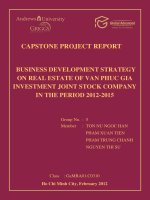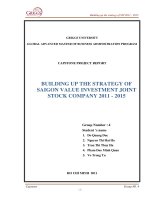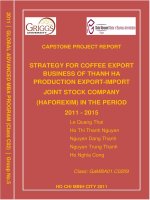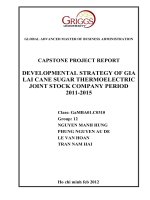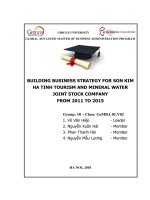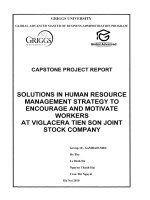BUILDING DEVELOPMENT STRATEGY FOR TERAZO TILES OF NAM THANG TRADE CONSTRUCTIVE INVESTMENT JOINT STOCK COMPANY
Bạn đang xem bản rút gọn của tài liệu. Xem và tải ngay bản đầy đủ của tài liệu tại đây (386.29 KB, 67 trang )
DISSERTATION
BUILDING DEVELOPMENT STRATEGY FOR TERAZO
TILES OF NAM THANG TRADE CONSTRUCTIVE
INVESTMENT JOINT STOCK COMPANY DURING THE
PERIOD OF 2011 – 2016
1
TABLE OF CONTENTS
LIST OF ABBREVIATION................................................................................................4
LIST OF FIGURES.............................................................................................................4
LIST OF TABLES...............................................................................................................4
ACKNOWLEDGEMENT...................................................................................................5
CHAPTER 1: LITERATURE REVIEW OF STRATEGY AND STRATEGIC
MANAGEMENT...............................................................................................................8
1.1. Fundamental definitions........................................................................................8
1.1.1. Definition of strategy.....................................................................................8
1.1.2. Definition of strategic management.............................................................10
1.1.3. Roles of strategic management....................................................................10
1.1.4. The meaning of building the business strategy............................................11
1.1.5. Process of building the business strategy ....................................................12
1.2. Analyze the external environment .....................................................................13
1.2.1 Analysis of macro environment....................................................................13
* Economy environment........................................................................................13
* Science-technology environment........................................................................14
* Culture-social environment ................................................................................14
* Demography environment .................................................................................14
* Political-legal environment.................................................................................14
* International environment...................................................................................15
1.2.2. Analysis of micro- environment..................................................................15
2.3.1.6. External Factor Evaluation EFE...........................................................18
1.2.3. Analyze the internal environment of the company......................................18
1.2.4. Strategy formulation ...................................................................................21
1.2.4.1. Strategy formulation process................................................................21
1.2.4.2. Analyze SWOT matrix ........................................................................22
1.2.5. The basic business strategies in the practice................................................22
CHAPTER 2: ANALYZING THE SITUATION BUSINESS STRATEGIES ON
TERAZO TILES OF NAM THANG TRADE CONSTRUCTIVE INVESTMENT
JSC....................................................................................................................................26
2.1. Introduction of Nam Thang trade constructive investment Joint Stock Company
26
2.1.1. History of development - Vision of the company........................................26
2.1.2. Managing structure of the company ...........................................................28
2.1.3. Production and business operations of the company ..................................30
2.2. Introduction about the products..........................................................................31
2
2.2.1. General characteristics of the product .........................................................31
2.2.2. Summarizing producing technology............................................................32
2.2.3. Distribution methods of products and sales services...................................33
2.3. External environment analysis............................................................................34
2.3.1. Macro environmental analysis.....................................................................34
2.3.1.1. Economic environment (E):..................................................................34
2.3.1.2. Political environment and legal (P):.....................................................35
2.3.1.3. Natural environment, culture, social (S):..............................................36
2.3.1.4. Technology Environmental (T):...........................................................37
2.3.1.5. International environment.....................................................................38
2.3.2.1 Analyze the industry environment.........................................................39
2.3.2.2 Analyzing micro-environment (analyzing five competitive forces) .....40
* Bargaining power of supplier..............................................................................41
2.4. Analyze the internal environment.......................................................................44
2.4.1. Resources.....................................................................................................44
2.4.2. Intangible resources.....................................................................................48
2.4.3. Production activities ....................................................................................50
2.4.4. Business activities .......................................................................................51
2.4.6. Internal factor evaluation matrix IFE...........................................................52
2.4.7. Using SWOT Matrix to making strategy for Terazo tiles of Nam Thang TCI
Joint Stock Company.............................................................................................53
CHAPTER 3: BUILD BUSINESS STRATEGY ON TERAZO TILES FOR...........56
NAM THANG TCI JOINT STOCK COMPANY IN...................................................56
THE PERIOD 2011-2016................................................................................................56
3.1. Developing objectives of Nam Thang TCI JSC.................................................56
3.1.1. Mission and vision confirm of the company................................................56
3.1.2 Development objectives ...............................................................................57
3.1.3. Analyzing SWOT Matrix to making strategy on Terazo tiles of Nam Thang
TCI JSC..................................................................................................................58
3.1.4. Choosing developing strategy......................................................................59
3.1.5. Solutions to build development strategy for Terazo tiles of Nam Thang TCI
JSC in the period 2011 – 2016...............................................................................62
CONCLUTION .................................................................................................................65
REFERENCE.....................................................................................................................66
3
LIST OF ABBREVIATION
AFTA
ASEAN
ASEM
Asean Free Trade Area
Association of Southeast Asian Nations
Asia-Europe Meeting
APEC
Asia-Pacific Economic Cooperation
CEO
JSC
R&D
SWOT
WTO
Chief executive officer
Joint Stock Company
Research and development
strengths, weaknesses, opportunities, threats
World Trade Organization
LIST OF FIGURES
Figure 1.1: Procedures of determining strategy
Figure 1.2: Model of 5 competitive forces by Mr. Porter
Figure 1.3: Process of building EFE matrix
Figure 1.4: Process of building IFE matrix
Figure 2.1: Organization structure of the company
Figure 2.2: Producing process
Figure 2.3: The market share
LIST OF TABLES
Table 1.1: SWOT Analysis minimalist framework
Table 1.2: Compare the characteristics of the general strategies
4
Table 1.3: Quantitative matrix according to the GREAT criteria
Table 2.1: The report of result on business activities
Table 2.2: Revenue by Terazo
Table 2.3 External Factor Evaluation matrix
Table 2.4: The substitute products
Table 2.5: The competitors
Table 2.6: Ballance sheet 2009 – 6/2011
Table 2.7: Labor quality
Table 2.8: Average income per labor
Table 2.9: Internal Factor Evaluation matrix
Table 2.10: SWOT analysis
Table 3.1: GREAT matrix
ACKNOWLEDGEMENT
First of all, the Group No.4 - GaMBA01.M1009 would like to express our sincere
thanks for the Master of Business Administration Program, the Affiliate Programs
between Griggs University, USA and Center for Education Technology and
5
Career Development, Vietnam University Hanoi for organize MBA course in
Vietnam and facilitating our Capstone Project Report.
Secondly, we would like to express our sincere thanks to the Leaders and
staffs of Nam Thang trade constructive investment Joint Stock Company, who
have fully supported our team in providing valuable input information for this
Capstone Project Report.
Last but not least, let our thanks go to our families whose encouragement
has helped us complete the course without having any difficulties.
We have tried to complete the assignment in the best way using our best
knowledge and ability. However, the shortcomings are inevitable. We wish to
receive valuable comments from teachers and colleagues.
INTRODUCTION
1. The title of research
“Building development strategy for Terazo tiles of Nam Thang trade constructive
investment Joint Stock Company in the period 2011-2016”
6
2. The reason of research
Vietnam has approached the market economy for over 20 years. This duration is
not too long as well as too short for Vietnamese enterprises to apply management
methods of the market economy procedure. Strategic management has been
considered as one of the most useful business theories which can help enterprises
to achieve successes in a long – term. The way they are using these theories,
however, should be re-considered in almost all organizations in Vietnam.
In 2002, with the approval of Hanoi Planning & Investment Department, Nam
Thang trade constructive investment Joint Stock Company was established and
started to build the most modern Terazo tiles in Vietnam by a technology chain
from Italy. All equipments of the factory are also controlled and checked by
experts from FDT – Italy. Through many years of developments, Terazo tiles - its
main product - has achieved a certain position step by step in the market as well as
in consumer’s mind.
In comparison with other products in the market, however, the awareness of
Terazo tiles is not really clear. Moreover, the company often encounters with the
situation of lacking products for sales because the production capacity of its
unique factory in Quoc Oai, Ha Tay cannot meet the increasing demand of
customers. In addition, there are more and more tiles products and the market is
becoming so competitive. It is clear that Terazo tiles is sort of clear and effective
strategies, especially marketing strategy or financial strategy to stay stable in the
material constructive industry.
This topic does not only apply knowledge of strategic management but also
contributes significant practical recommendations for the development of Nam
Thang trade constructive investment Joint Stock Company as well as Terazo
brand.
3. Purposes of the research
The research focused on following issues:
-
Fundamental theories of strategy and strategic management.
7
-
Useful models to analyze the process of establishing and choosing strategy.
-
The real situation in which Nam Thang trade constructive investment Joint
Stock Company has been implementing its strategy for Terazo tiles
-
Analyze factors of the external and internal environment which affect on
company’s strategy
-
Appropriate solutions to build the development strategy for Terazo brand of
Nam Thang trade constructive investment Joint Stock Company.
4. Objective, scale and methodology
-
Objective and scale: The research focuses on current strategic management
activities of Nam Thang trade constructive investment Joint Stock
Company and provides some solutions for the period of 2011-2016.
-
Methodology: The research used two kinds of information sources: Primary
and secondary information. The secondary information came from various
sources. However, a major percentage of them were from reports about
current business situations of Terazo tiles which were provided by Nam
Thang trade constructive investment Joint Stock Company. Besides, we
were also gathered from many opened sources such as internet and books.
5. Structure of the research
Introduction
Chapter 1: Literature review of strategy and strategic management
Chapter 2: Analyzing the situation business strategies on Terazo tiles of Nam
Thang trade constructive investment jsc
Chapter 3: Some solutions to build development strategy on Tarezo tiles of Nam
Thang trade constructive investment jsc
CHAPTER 1: LITERATURE REVIEW OF STRATEGY AND STRATEGIC
MANAGEMENT
1.1. Fundamental definitions
1.1.1. Definition of strategy
8
There are many different definitions on strategy, but the most popular definition is
"Strategy is a series of complex actions to mobilize the resources of an
organization to achieve a certain goal." – Text book of “Strategic Management”Global Advanced Master of Business Administration, Hanoi, 2010.
We know that in all definitions of policy there is some word with different
meaning. According to Mr.Mintzberg, there is 5 words (5P): Plan, Partern,
Position, Perspective, Ploy. Until now, Plan is an important part in definition of
business strategy. Alfred Chadler (Harvard University) thinks that “strategy is to
determine long –term corporate targets, to select method or plan of
implementation and distribution resources necessary for achieving that target”. (Source: Johnson & Scholes- Exploring Corporate Strategy, 2009)
There is a lot of such definitions, because strategy has a large concept with
complicated meaning. However, strategy can be recognized by certifying its
character and by distinguishing strategy and tactics.
* By characters, strategy has 3 main following contents:
-
Long-term missions that company wishes to achieve.
-
Setting-up and selecting the solutions for achieving mission.
-
Implementing and distributing resources for mission achievement.
Corporate business strategy is master action program to focus on mission
achievement. Strategy does not define exact method to achieve the mission,
because this is the target of other supplemented programs. Strategy makes only the
frame of guidance on mind and action for corporate management leaders.
* By level, in any business corporate, strategy has some different levels,
along whole the corporation (or some of corporations) to every employee who
works in the corporation.
+ Corporate strategy: is at corporate level to focus on master mission with whole
corporate scope, satisfying expectations by owners of capital contribution.
+ Business strategy: is in relation with how corporation can compete successfully
in the market.
9
+ Functional strategy – is strategy supported to corporate and business strategy
achieving the mission based on recourses, procedures, personnel and other
necessary skills.
+ World-wide strategy (international business) – is a selection, facing to
international business when corporate operates multiple business outside its
border.
1.1.2. Definition of strategic management
Strategic management is the art and science of formulating, implementing and
evaluating cross-functional decisions that will enable an organization to achieve its
objectives. It involves the systematic identification of specifying the firm's
objectives, nurturing policies and strategies to achieve these objectives, and
acquiring and making available these resources to implement the policies and
strategies to achieve the firm's objectives. Strategic management, therefore,
integrates the activities of the various functional sectors of a business, such as
marketing, sales, production etc., to achieve organizational goals. It is generally
the highest level of managerial activity, usually initiated by the board of directors
and executed by the firm's Chief Executive Officer (CEO) and executive team.
Strategic management hopes to provide overall direction to the company has ties
to the field of organization studies.
Strategic management includes these following specific steps:
• Strategic planning
• Strategic implement
• Strategic checking and evaluation.
1.1.3. Roles of strategic management
Characteristics of business environment have a big affect to existence and
development of company. They can create new opportunities and challenges for
corporation. And the company which wants to exist has to find out a new
management method, it is exactly “strategic management” - strategy is the basis of
10
this management method. In model business environment, strategy becomes more
and more important to existence of company.
From below analysis we can see very important roles of strategy in enterprise’s
performance so; strategic management becomes one of the most necessary keys
which help enterprise open the door to advance toward success. Strategic
management brings theses following advantages:
More efficient in making plans by using more reasonable and logical approach
method when choosing strategies
• Widely take care of related beneficiaries of enterprises (stock holders)
• Connect short term development in long term development.
• Take care of both efficiency and effectiveness.
1.1.4. The meaning of building the business strategy
Setting up business strategy is one of the most important activities managed by the
corporate leaders. This gives to corporate the best benefits, such as:
- Define exactly the corporate mission in every business period; Support corporate
to have a future trend for achievement of targeted mission.
- Help corporate leaders to see opportunities and challenges from outside, to know
the corporate strong & weak point, to forecast the changes in the future and to
have possible solutions for competition and satisfying with new business
conditions.
- Help corporate to control and use effectively all resources, to promote the most
of corporate abilities for development.
- Help corporate to distribute reasonable resources in every period, to improve
corporate business result.
- Improve the corporation and agreement between company leaders to get the
targeted mission.
-
Help corporation to increase human resource productivity, increase sales
revenue, improve corporate management, minimize the risks and stop difficulties
may occurred with corporation.
11
We can conclude that business strategy can help corporate leaders to define the
mission and ability to set up stable competitive opportunity.
1.1.5. Process of building the business strategy
Setting up business strategy is a procedure of business definition. It’s
summarized definition of business strategy as followings:
Figures 1.1: Procedures of determining strategy
Define the
strategy
Determine the
functions and tasks
Evaluate external
environment
Macroenvironment
Industry
environment
Evaluate internal
environment
Analyze and choose
the strategy
(Source: Text book of “Strategic Management”- Global Advanced Master of
Business Administration, Hanoi, 2010)
* Definition of corporate tasks and functions
Firstly, this is to define corporate task and function, including mission and goal.
- Mission: define exactly corporate problems and show how to do
-Vision: it’s mission detailed by general goal, having trust on corporate future
- Strategic target: define the corporate tasks, and other goals that corporate hopes
to achieve in medium and long term plan.
Factors that can effect to corporate business are defined in two groups:
12
(i) Environment outside corporation and
(ii) Environment inside corporation.
1.2. Analyze the external environment
No organization can exist in a vacuum; each is set in a particular country and
region to which it is inextricably linked. This setting provides multiple contexts
that influence how the organization operates and how and what it produces. Thus,
the concept of "external environment" is an important consideration for
organizations as it attempts to understand the research institutions it supports. An
analysis of the external environment is an attempt to understand the forces outside
organizational boundaries that are helping to shape the organization.
Forces outside the institution's walls clearly have considerable bearing on that
which transpires within. The external environment can provide both facilitating
and inhibiting influences on organizational performance. Multiple influences in
the immediate or proximal environment form the boundaries within which an
organization is able to function; these influences likewise shape how the
organization defines itself and how it articulates what is good and appropriate to
achieve.
External environment is divided into 2 following perspectives: Macro and Micro
1.2.1 Analysis of macro environment
Any changes of macro environment can effect to any corporation of the industry,
can change power and industry challenge. Macro environment includes 6
economic sectors: economy, technology, culture-social, demography, political and
law.
* Economy environment
State of economy environment defines the healthy and prosperous of the economy.
It always effects to corporations and industries. Economy environment certifies
the nature and trend of the economy in which corporation involves. The effects
caused by economy environment can change profit and earning ability operated by
13
the corporation. 4 factors are important in macro economy: ratio of economy
development, foreign exchange rate, interest and inflation rate.
* Science-technology environment
Changes of technology can effect to many social sectors through its products,
including substance, activities related to creativeness of new knowledge,
movement of new knowledge to new products or new cycle or new material. The
change of technology environment can give to corporation opportunity and
challenge; Opportunity is to improve production of new competitive product;
challenge is to shorten the product life.
* Culture-social environment
This is included social manner and culture value; social change can set up
opportunity and challenge. The corporation that wishes to be alive forever with
time and partners and wish to be recognized by social environment should
appreciate business culture; that’s why it can lead some changes of technology,
political, law, economy and demography.
* Demography environment
This is related to population, age structure, geography distribution and income
distribution. Opinion of goods and service consume in different geography area
and point of consumer’s view different age or male/female or job can effect to the
market and to corporation business strategy. Living style can effect to goods &
service demand, including product grade, quality, form. Population increase can
effect to the content of corporate business strategy.
* Political-legal environment
The change of political-legal environment can effect deeply to implementation of
corporate business strategy. In fact that a corporation, investing in new area local
or international should pay attention to political-legal environment of the invested
area, its effect to local Government and vise versa. When analyzing this
environment we should focus on: economy innovation, administrative reform,
14
changes related to the industry, tax regulations, safety and environment protection,
issuance and adjustment of regulations.
Nowadays, corporation should pay more attention to Government regulations on
using and protection of natural resources. Good environment protection is an
essential condition for stable development.
* International environment
Trend of worldwide integration asks corporation to consider international effect if
it defines a long-term business strategy with high integration and high trend in
political and geography. International market division includes: worldwide related
market, current market changeable, international political issues, government and
cultural basis on the world.
1.2.2. Analysis of micro- environment
To analyze the micro-environment, organizations often use five-force model of M.
Porter – Father of competitive theories. Michael Porter provided a framework that
models an industry as being influenced by five forces. The strategic business
manager seeking to develop an edge over rival firms can use this model to better
understand the industry context in which the firm operates.
Mr. Porter indicates that these forces are stronger, minimize its ability in price
increasing and high earnings. The task setting for corporate managers is to
recognize the opportunity and challenger.
Figures 1.2: Model of 5 competitive forces by Mr. Porter
15
(Source: www.salesmarketinghelpcentral.blogspot.com)
* Threat of new entry can represent in these facts: In nature this force concludes
the companies that have no competition in industry, but they can enter in because
they have implicit of competition, and industry attractiveness and other entering
barrier. Entering barrier is the most difficult for other competitive corporations
Sponsor for competitive position of the company includes the maintain of legal
barrier and the current opportunity of the company. It consists of:
+ Faithful to trade mark: it is a customer’s love of company current product.
+ Absolute cost advantage: the best operation through experiences; control of
input, labor cost, material, equipment, management skill,…approach to capital
with low interest. When industry companies have absolute advantage the
threatening of current companies may decrease.
+ Economical scale: effective for company with many experiences when scale
increases.
16
+ Cost of movement appears when customer changes his shopping from this
company to another.
+ Government barrier regulations.
+ Retaliatory measure of other industry companies.
+ Becoming a member and other competitive barrier.
* Bargaining power of supplier can have some features, such as: Suppliers can
be a warning force when they can increase input price or reduce quality of product
and service to be supplied and company profit can be decreased. Level of effective
depends on supplier’s focus, quantity of sold goods, different between suppliers,
effective of input to company cost or difference between products, cost movement
of industry companies, existence of replaceable supplier, a merger of suppliers,
supplying cost.
* Bargaining power of customers can have such features: Buyer as threatening
when they ask lower price or better service. Level of effective depends on:
position in negotiation, quantity of buyers, information that buyer can have,
character of product trade mark, essential level to price, product difference,
existence of replaceable product, customer needs, ability of buyer when he can
use another supplier.
* Threat of substitutes can have such futures: Industry products to be supplied to
the customers with the same product of industry analyzing. Level effective
depends on: cost of movement of product using, trend of using replaceable
product, relation between price and quality.
* Rivalry among existing competitors
And last but not least, this describes the intensity of competition between existing
firms in an industry. Highly competitive industries generally earn low returns
because the cost of competition is high. A highly competitive market might result
from:
•
Many players of about the same size, no dominant firm.
•
Little differentiation between competitor’s products and services.
17
•
A mature industry with very little growth.
•
Companies can only grow by stealing customers away from competitors.
2.3.1.6. External Factor Evaluation EFE
External Factor Evaluation (EFE) matrix method is a strategic-management tool
often used for assessment of current business conditions. The EFE matrix is a
good tool to visualize and prioritize the opportunities and threats that a business is
facing. Five steps to create EFE matrix:
EFE Matrix
List of
external
factors
The
level of
importa
nce of
factors
0,0 ÷ 1
Shortin
g of
factors
1÷4
Scoring
the
factors
Sum of
scores
for
factors
in the
list
Figure 1.3: Process of building EFE matrix
(Source: Text book of “Strategic Management”- Global Advanced Master of
Business Administration, Hanoi, 2010)
The sum of all weighted score is equal to the total weighted score; final value of
total weighted score should be between ranges from 1.0 (low) to 4.0(high).
1.2.3. Analyze the internal environment of the company
The organization not only needs to be aware of the social, political and economic
environment in which it is operating, but also its internal environment ¾ its own
strengths and weaknesses.
Nam Thang TCI JSC should know competitor about: Who is competitor? What is
their corporate business? What is their mission? What are their strong and weak
point? How are their action? We can review these information whether they can
support so much to corporation in definition of corporate business strategy.
18
The main factors are corporate value chain and internal corporate capability, such
as: production line, Marketing, management activities, accounting-financial, study
and development, system recovering and resolving information.
* Producing activities
Analysis of production operation is to review product manufacturing cycle in
compliance with corporate business policy or not and give comment for
improvement if necessary.
- Analysis of production capability: production capability is ability to produce the
products in compliance with technical norms regulated in that time. It can present
ability of production factors , such as equipment and technology
- Analysis of raw material, energy and spare part supply: this is to analyze mainly
quality, trust and prompt supply by supply sources.
- Analysis of reasonable production: it’s mainly to analyze production
organization and operation manual, continuous and technical equipment ability
satisfied with product change.
- Analysis of quality control: it’s mainly to analyze role of quality control system
and its efficiency.
* Marketing activities
Marketing strategy is one of important part related to implementation of corporate
business strategy.
Marketing helps in set up value chain in corporate operation. Through dedicating
trade mark and advertisement, marketing functions can make added value for
customers. This activity can make a good impression for customer, so it makes
value added for them. Marketing and selling can make more added value if they
know well customer’s needs and inform to study and development activity to
produce the product that customer likes.
Role of customer service is to provide service or support after sales. It can make
good impression by customer after they bought product.
* Managing activities
19
Corporate management activities are a set of activities supported to main operation
in corporate value chain.
Infrastructure
This is to analyze reasonable investment of building factory, utility system, infrastructure
to ensure normal operation, equipment operation and product quality.
Human resource management
Corporate organization is a set of human resources. Reasonable organization has
united instruct, un-coincidence, conflict in instruct, chaos in informatics system
.Corporate operation is a living subject. Management leaders should analyze its
mission and results, compliance between responsibility and power, relationship
between corporation and departments, functions of corporate employees. Through
this analysis, we can know problems to be resolved or adjusted.
Raw material management
This mission is material movement from buying to distribution. So, cost can be
minimizes and operation can be more effective. Using strict control of inventory
from store house to customer, company can reduce stocks on hand, minimize cost
and have added value.
System recovering and resolving information
System recovering and resolving information is a group of technology staff to recover
and resolve information related to product, customer, product distribution system, trade
mark and logo, human resource management in order to provide resolved information to
corporate leaders, helping them to analyze and set –up business strategy. This system is
more important for company in current period.
Financial management
Financial resources are the most basic and the first for other resources. Analysis of
financial resources and appraisal of corporate financial potentiality are the
conditions for investment capital. This a basic factor for setting up feasible
business strategy.
* Research and development (R&D.)
20
Research and development can make production more effectively, minimize cost.
R&D can improve product quantity and make it more attractive to customer. At
the current time when technology has developed too fast, research and
development activities can support corporate to hold modern technology ,
applying in company operation.
Internal Factor Evaluation
Internal Factor Evaluation (IFE) matrix is a strategic management tool for auditing or
evaluating major strengths and weaknesses in functional areas of a business. IFE matrix
also provides a basis for identifying and evaluating relationships among those areas. The
Internal Factor Evaluation matrix or short IFE matrix is used in strategy formulation.
This matrix is built through 5 following steps:
IFE Matrix:
Figure 1.4: Process of building IFE matrix
List of
factors
of the
internal
environ
(Source:
ment
Determi
ne the
level of
importa
nce of
the
factors
Rank
the
factors
1÷4
Scoring
the
factors
Sum of
the
scores
for the
factors
in the
list
Text book of “Strategic Management”- Global Advanced Master of Business
Administration, Hanoi, 2010)
We use IE Matrix to synthesize the levels of impact made by the factors of the
internal and external environments on the enterprise.
Total weighted scores well below 2.5 point to internally weak business. Scores
significantly above 2.5 indicate a strong internal position..
1.2.4. Strategy formulation
1.2.4.1. Strategy formulation process
21
Strategy formulation is the process of determining appropriate courses of action
for achieving organizational objectives and thereby accomplishing organizational
purpose. The strategy the company formulates should reflect environmental
analysis, lead to fulfillment of organizational vision, and result in reaching
organizational objectives. Special tools the company can use to assist it in
formulating strategies include critical question analysis, SWOT analysis, business
portfolio analysis, Porter's model for industry analysis, and resource-based model.
These five strategy development tools are related but distinct. The company
should use the tool or combination of tools that is most appropriate for the
company and business environment.
1.2.4.2. Analyze SWOT matrix
SWOT is abbreviation of English words: Strengths; Weaknesses; Opportunities;
Threats. This is an effective tool for more understanding or making decision
related to corporate organization and business management.
SWOT analysis can be summarized as below:
Table 1.1 SWOT Analysis minimalist frame work
Environment S- strength
Outside environment
O opportunity
T threat
S-O: encourage strong S-T: encourage strong
inside
point to get opportunity, point
Environment analysis
W- weakness
to
minimize
define business policy
weakness
W-O:
overcome W-T: overcome internal
weakness
to
get difficulties and prepare
opportunity
carefully
to
overcome
challenges from outside
1.2.5. The basic business strategies in the practice
A company, focusing on market and customer is in the centre, can concentrate
more on customer development during defining business strategy.
(1) Customer needs: What they should be satisfied with;
22
(2) Group of customers: Who will be satisfied;
(3) Other special ability: How customer’s need could be satisfied.
This is the main issue for selecting corporate business strategy, because it is basis
for definition of business opportunity and of competitive method.
Strategy in the context of five overall competitive forces
Table 1.2: Compare the characteristics of the general strategies
Five
competitive
Cost leading
Strategies
differentiate
focus
Threats from
Observing ability
products
Customers' loyalty The focus that create
new opponents
to counter
can upset new
specialization of the
preventing other
joined competitors
company has the
companies from
effects as a barrier
Negotiating
joining
Ability to introduce Powerful
prevent joining
Powerful customers
ability of
low price to
customers have
have less advantages
customers
powerful
less advantages in
because there are few
customers
negotiation
choice
because they cant
find substitute
Negotiating
Better protection
products
Easily transfer the
ability of
ability against
increase price of
negotiating with
suppliers
powerful suppliers
suppliers into
suppliers, as the
customer
company has low
Lower position in
output, but
businesses pursuing
focus strategy on
differentiating
23
products can transfer
the increased price in
Risk of
Able to use lower
Customers
to customers
Products with high
substitute
price to protect
become attached
specialization and
products from
to the
superiority protect
being substituted
distinguished
company against
characteristics of
substitution
products, thereby
reduce the risk of
Competitive
Better
substitute
Customers' loyalty Competitors cannot
intension
competitiveness in
protect company
supply the needs of
price
from losing
customers as the
customers into
company pursuing
other competitors'
focus strategy of
hands
differentiating
products
(Source: Nguyen Thanh Thao, "Brand strategy” by theory, Michael Porter)
These common strategies can be applied to protect enterprises against competitive
forces. Diagram above is to compare the characteristics of the overall strategies in
the context of the environment of five competitive forces.
Selection of the best business strategy
Based on a set of policies, defining the combination between StrengthOpportunity, Strength-Threat, Weakness-Opportunity, Weakness-Threat, you can
use GREAT model to make the base of business selection:
Table 1.3: Quantitative matrix according to the GREAT criteria
Es
se
Policy 1
Mark of Equiva
Policies
Policy 2
Mark of Equival
…
Policy n
Mark of Equival
24
Column1
2
Benefit (G)
Risk
(R)
Cost
(E)
Possibility(A)
Time
(T)
Total
1
appraisal
lent
3
mark
4=2x3
appraisal ent
5
Xx
mark
6=2x5
appraisal ent
… I
Xx
mark
j=2xi
xx
Step 1: Recognize main content to be analyzed or belong to column 1
Step 2: Appraise efficiency of factors to general strategy; use ratio dedicating
importance and efficiency to strategy (ratio counting from 0 to 1 with total equal
1)
Step 3: Appraise and mark every factor of strategy. Mark counting from 1 to 5:
weak, normal, over normal, good, best.
Step 4: Convert ratio as result of column 2, then summarizes results as in last
column
Finally, highlight from one to three best numbers and that is the focus strategy
which should be focused on implementation.
Chapter 1 mini conclusion
Above is the basis of theoretical concepts and basic terminology as a basis for the
development of business strategy for enterprises. Theories and methods which are:
how to understand the strategy, steps to build strategies, methods of evaluation
analysis, integrated assessment methods, methods of proposing strategies and
methods of selecting optimal strategies.
Theories and methods above will be applied in the analysis of activity
environment and building strategies on Terazo tiles of Nam Thang trade
constructive investment Joint Stock Company
25




